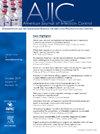Understanding context to plan antimicrobial stewardship: A mixed-method study in a Brazilian urban primary care
IF 3.8
3区 医学
Q2 INFECTIOUS DISEASES
引用次数: 0
Abstract
Background
The Centres for Antimicrobial Optimization Network Brazil aims to implement an antimicrobial stewardship program in Brazilian municipality. This study explores barriers and enablers to its implementation, through understanding the context and beliefs regarding antimicrobial use in this environment.
Methods
The study occurred in 12 primary health care units, where a mixed-method study was conducted. A total of 208 out of 450 health care workers completed a Theoretical Domain Framework-based survey, and 16 patients and 12 health workers were interviewed. Survey results were compared by professional category; interviews were analyzed using Critical Discourse Analysis.
Results
Professionals with higher education scored higher across most domains. In the “Optimism” domain, these professionals scored ≥6.0, while others scored ≤5.0. Similar patterns were observed in the domains “Knowledge” (≥6.0 vs ≤5.5), “Social/professional role and identity” (≥6.36 vs ≤5.79), and “Intentions” (≥6.0 vs ≤5.0). Qualitative data highlighted breaks in the continuity of care and gaps in patient knowledge about antimicrobial use. Key barriers included disparities in training, physician-centered decision-making, and patient knowledge gaps. Enablers included health care workers' willingness to learn and home caregivers' understanding of patient conditions.
Conclusions
The implementation of the antimicrobial stewardship program depends on addressing training disparities and leveraging health care workers' willingness to learn.
了解计划抗菌药物管理的背景:巴西城市初级保健的混合方法研究。
背景:巴西抗微生物药物优化网络中心(CAMO-Net Brazil)旨在在一个拥有16.5万居民的城市实施一项抗微生物药物管理计划。本研究通过了解在这种环境中使用抗菌素的背景和信念,探索其实施的障碍和促进因素。程序:该研究在圣保罗大都市区的12个初级保健单位进行,在那里进行了一项趋同平行混合方法研究,即同时收集定量和定性数据,分别进行分析,然后将其结果整合到一个独特的讨论中。450名医护人员中,共有208人完成了基于理论领域框架的调查,并对16名患者和12名医护人员进行了访谈。按专业类别比较调查结果;访谈采用批评话语分析法进行分析。研究发现:受过高等教育的专业人士在大多数领域得分更高。在“乐观”领域,护士、医生、牙医和药剂师得分≥6.0分,其他得分≤5.0分。在“知识”(≥6·0 vs≤5·5)、“社会/职业角色和认同”(≥6·36 vs≤5·79)和“意图”(≥6·0 vs≤5·0)领域也观察到类似的模式。定性数据突出了护理连续性的中断以及患者和护理人员对抗微生物药物使用知识的差距。主要障碍包括培训差异、以医生为中心的决策和患者知识差距。促成因素包括医护人员的学习意愿和家庭护理人员对患者病情的了解。家庭照顾者成为实施过程中的关键利益攸关方。结论:抗菌药物管理计划的实施取决于解决培训差异和利用医护人员的学习意愿。
本文章由计算机程序翻译,如有差异,请以英文原文为准。
求助全文
约1分钟内获得全文
求助全文
来源期刊
CiteScore
7.40
自引率
4.10%
发文量
479
审稿时长
24 days
期刊介绍:
AJIC covers key topics and issues in infection control and epidemiology. Infection control professionals, including physicians, nurses, and epidemiologists, rely on AJIC for peer-reviewed articles covering clinical topics as well as original research. As the official publication of the Association for Professionals in Infection Control and Epidemiology (APIC)

 求助内容:
求助内容: 应助结果提醒方式:
应助结果提醒方式:


